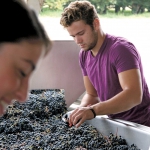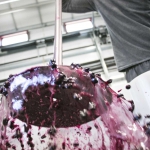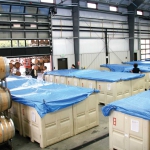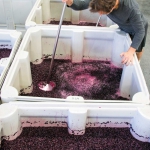It’s expected that wineries are busiest during crush, but at Owen Roe Winery, the place buzzes a little more than usual with people and activity.
Wines made there are labor-intensive, and the grapes and juice are handled as gently as possible, from picking to pressing to racking.
During crush last fall, the winery crew was busy—three workers were on the sorting line, picking out green and off-colored berries; two were cleaning and sanitizing floors and windows in the fermenting room to prevent contamination from fruit flies; four were wetting down and filling oak barrels with juice; others were moving barrels, working in the tank room; one was updating computer records; and two were preparing lunch for the group.
Owen Roe Washington is a medium-sized estate winery located in Yakima Valley near the narrowing of the Yakima River at Union Gap. David O’Reilly is grower, winemaker, and co-owner of the winery that has about 150 acres of wine grapes planted at its Union Gap and Outlook vineyards. A sister winery, Owen Roe Oregon, is located in Newburg, though no estate grapes are grown in Oregon.
O’Reilly admits that he’s overstaffed for a winery his size. (The winery crushed about 350 tons last harvest and annually produces about 25,000 cases.) “We have a crew of about 20 on the floor during crush,” he said. “For a winery our size, that’s a lot of people.”
Wineries many times larger, handling millions of gallons, do so with only a handful of workers.
“I do overhire,” he said. “But when producing premium wines, you have to pay attention to detail. I’m also the winemaker for our Oregon winery, and I can’t be in two places at once.”
Labor intensive
Moreover, O’Reilly’s minimalist approach to winemaking requires extra hands.
Grapes are hand picked and hand sorted before going through the de-stemmer. Whole grapes are fermented in plastic bins, and punch downs (pushing the floating cap of grape skins, pulp, and seeds down into the juice to mix it up) are done by hand. No must pumping is done.
His red winemaking techniques are unusual because he aims to keep the berries whole during crush and fermentation. Though red grape varieties aren’t crushed like white varieties, they typically go through some maceration to release juices before fermentation. O’Reilly skips that step in his red winemaking.
“We try not to rupture the seeds and skins during the winemaking process,” he said, adding that he also uses a gentle touch when pressing (extracting juice from the skins). His French-made press called Les Pressoirs Coquard uses a peristaltic pump at very low pressure of .25 bar to extract juices after fermentation. The unique press is one of only two used in the state, he says.
“The low pressure results in wines that are very textural, even when they are young,” O’Reilly said. He explained that while he’s trying to accentuate texture and flavors, he’s really after texture. “I want to present in my wines the great chemistry and balance between pH and acidity that Yakima Valley grapes are known for.”
He also uses gravity when racking (moving wine from one barrel or tank to another to help filter sediment) instead of using pumps. Pumping is said to be disruptive to a wine. Free run juice is kept separate from pressed juice and is put directly in barrels to give O’Reilly more blending options.
O’Reilly does all the blending at the Oregon and Washington wineries. He annually goes through about 1,200 barrels, mixing and matching lots together.
Software developed for the wine industry greatly helps with his blending. The software program tracks everything done to each lot of fruit. Though much of O’Reilly’s blending work is first done on paper, based on notes from past blends, he said it still requires a keen sense of taste and smell.
Owen Roe wines are made from estate-grown grapes and mostly from grapes purchased from some of the top vineyards in Yakima and Columbia Valleys. The list includes Red Willow, DuBrul, Elerding, Echo Ridge, Olsen Brothers, Gunkel, and Destiny Ridge. Owen Roe has become one of the biggest buyers of grapes grown by Red Willow’s Mike Sauer.
In addition to his hands-on winemaking style, he believes in giving college interns work experience. During Good Fruit Grower’s visit last fall, nearly half of his crew of 20 were interns. The interns came from a variety of wine education programs, including those of Washington State University, Central Washington University, Yakima Valley Community College, and foreign countries.
2014 marked the first year that Union Gap estate grapes were crushed and made into wine at the relatively new Owen Roe winery.
Having the winery within a baseball throw of the vines is a dream come true, said O’Reilly. “There’s never any trucking issues or question about what’s happening in the vineyard. Grapes don’t sit in bins for hours waiting for delivery. It’s like having my cake and eating it, too.”
The extra work required in making Owen Roe wines is paying off. The winery has never entered a wine competition, but the highly sought after inventory disappears quickly and vintages sell out fast. Wine critics routinely score Owen Roe wines with outstanding scores. The top tier Owen Roe wines retail for more than $70 per bottle. However, value wines are also made that retail at around $15.
“If you get your wines in the right people’s hands and in great restaurants, you don’t need to enter contests,” he said, naming top restaurants in New York, Chicago, San Francisco, Portland, and Seattle that feature Owen Roe wines. “Wine writers now come here, to us, to taste our wines.” •










Leave A Comment